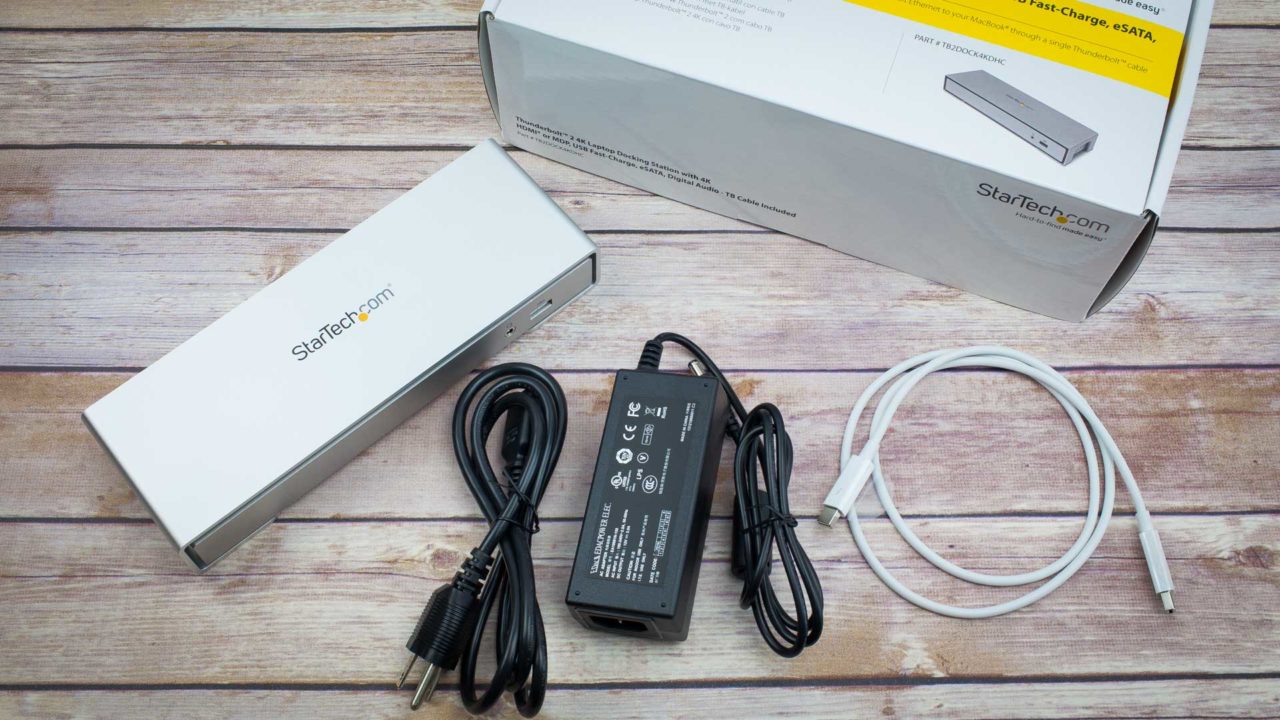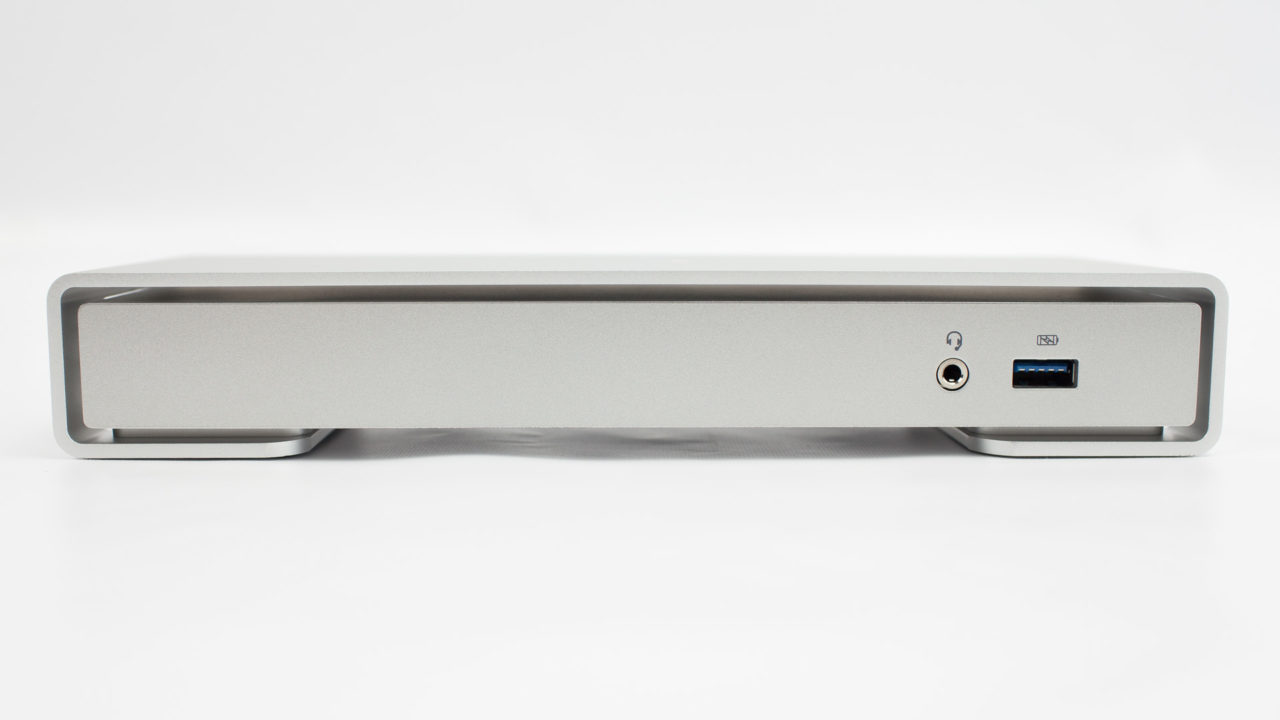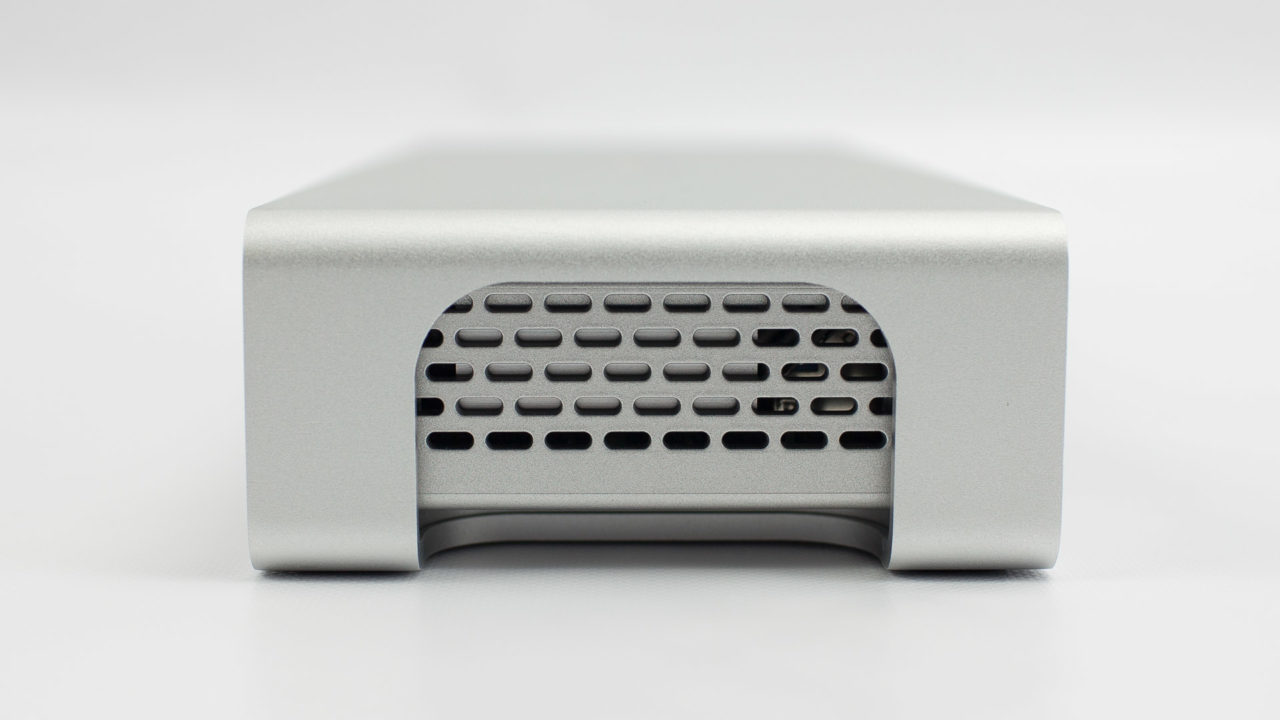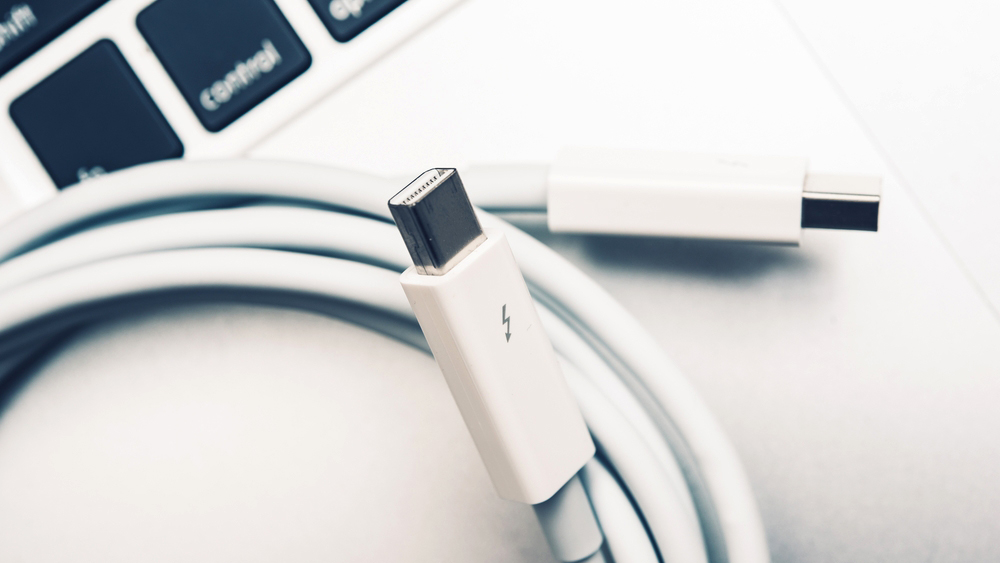StarTech Thunderbolt 2 4K Docking Station
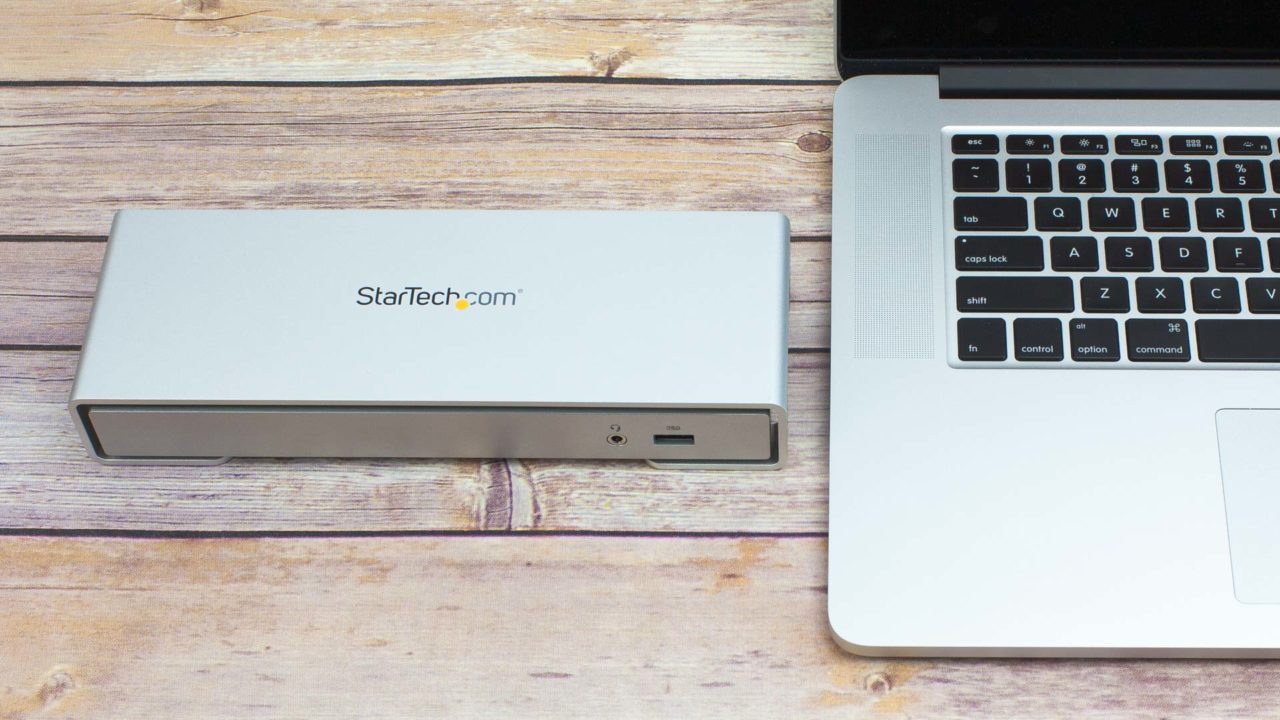
Apple (and Google) recently introduced the new USB-C specification to the market, and while the new port is much more versatile than its predecessors, don’t think that Thunderbolt is going anywhere, at least any time soon. Thunderbolt 2 offers significantly faster bandwidth, daisy chaining support, and a wider range of supported device types and peripherals. Perhaps the most interesting use of Thunderbolt has been the docking station, a device that lets you make a single connection to your Mac or Thunderbolt-equipped PC and then enjoy access to a variety of displays, data ports, networking, and audio interfaces.
We’ve looked at several Thunderbolt docking stations in recent years, including some that have been updated for Thunderbolt 2. The latest is from StarTech, a technology manufacturer that produces a wide range of computing devices and accessories. The StarTech Thunderbolt 2 4K Docking Station isn’t the company’s first foray into the docking station market (they also offer a USB 3.0-based docking station and one based on first-generation Thunderbolt), but it’s one of the most versatile when it comes to port selection and, in our opinion, one of the most attractive docks from a design perspective.
We spent a few weeks using the StarTech Thunderbolt 2 Dock with our 15-inch Retina MacBook Pro, 2013 Mac Pro, and a variety of displays and storage devices, and we were left with a very positive impression. The StarTech dock performed well in all scenarios, was cool and quiet (actually, that’s an understatement — the dock was completely silent), and it offers some unique ports that are hard to find on other products. The only drawback is the price, which we’ll look at in detail below.
Box Contents & Design
Very few early Thunderbolt products included a Thunderbolt cable in the box and, with cables costing as much as $50, it was a trend we are glad to see die. The StarTech Thunderbolt 2 Docking Station includes everything you need to get started: the dock itself, a power adapter, international power cords (North America, United Kingdom, and European Union), and a 1-meter Thunderbolt cable.
When you remove the StarTech dock from its packaging, you’ll instantly recognize the design styling of the pre-2013 “Tower” Mac Pro. The dock is crafted from aluminum that matches the color and texture of most of Apple’s Macs (excluding, of course, the glossy black Mac Pro and the new gold and space gray 12-inch MacBooks), and features a interesting “encased” design, where an outer layer wraps around the core dock, providing some elevation off of your desk as well as a unique look.
As with all Thunderbolt docks, the majority of the ports are on the rear, but there is a USB 3.0 port and 3.5mm headphone/speaker jack on the front of the device for easy access. There’s also a Kensington lock slot on the rear, helping secure your dock in a public or shared space. Attractive recessed vents flank the dock on either side, and slim rubber feet keep the dock from sliding around or scratching your desk
At 9.2 inches wide, by 1.5 inches tall, by 3.2 inches deep, the dock takes up a little bit more room on your desk than most of its competitors, but it looks so good you probably won’t mind unless space is at an absolute premium.
Technical Specifications
There are no shortage of ports on the StarTech Thunderbolt 2 Dock, and it even includes some ports you won’t find anywhere else:
2 x Thunderbolt 2
1 x HDMI 1.4
4 x USB 3.0 5Gbps (3 rear, 1 “fast-charge” port in front)
1 x eSATA 6Gbps
1 x Toslink optical audio
1 x 3.5mm audio input (rear)
1 x 3.5mm audio output (front)
1 x Gigabit Ethernet
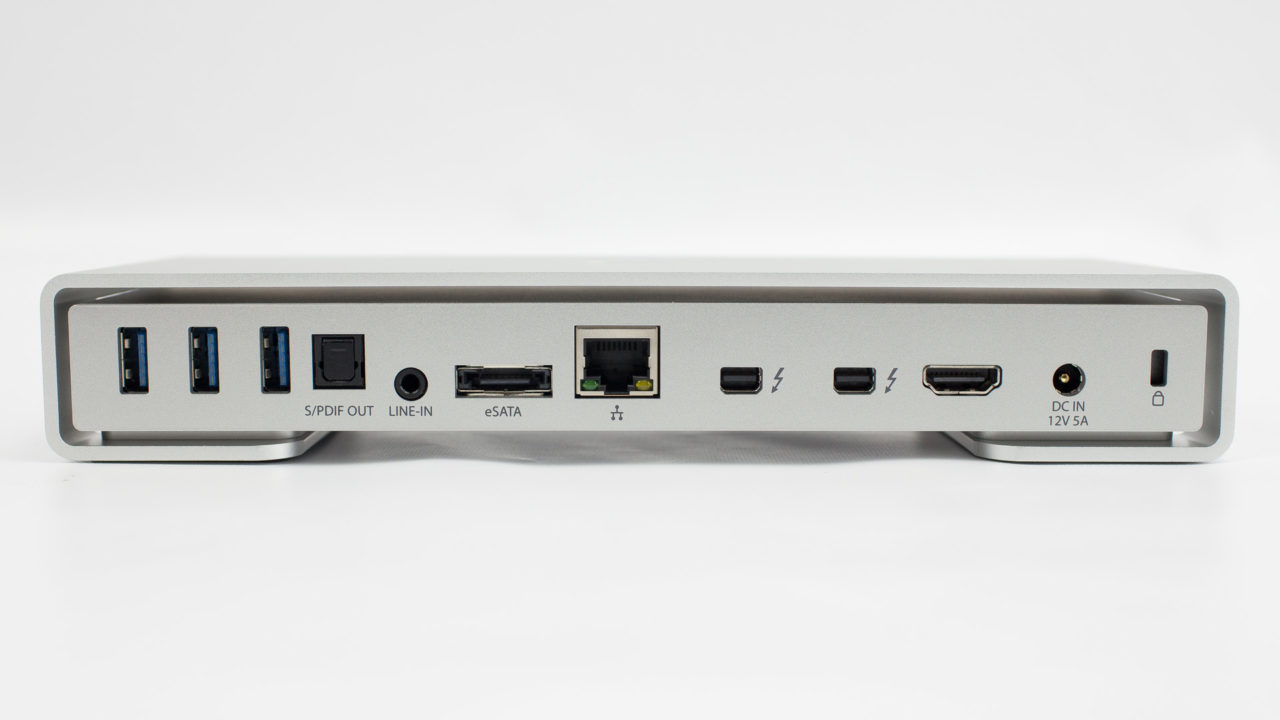
All ports worked as expected, and the optical audio port was particularly useful as we were able to pass 5.1 multi-channel digital audio directly to our home theater receiver and enjoy music and movies on the big speakers. The only other Thunderbolt dock we’re aware of that supports optical audio out is the Sonnet Echo 15, but that dock has yet to hit the market, nearly three years after it was first announced. You can also pass audio via HDMI if the connected display or television supports it.
Speaking of displays, that’s one area that might cause confusion (which is common to many Thunderbolt docks). Attaching virtually any single display works great via either HDMI or Thunderbolt/DisplayPort. We had no problem with a Dell U2415 (1920×1200), Dell P2715Q (3840×2160), Samsung U28D590D (3840×2160), or Apple Thunderbolt Display (2560×1440). But things get tricky when you want to connect two displays simultaneously.
Multi-display output is definitely possible with the StarTech Thunderbolt 2 Dock, but one of those displays must be connected via Thunderbolt. And we don’t mean Mini DisplayPort, which shares the same connector with Thunderbolt, we mean Thunderbolt. That will limit you to Apple’s Thunderbolt Display or one of the few third party Thunderbolt monitors currently on the market. If one of your displays is connected via Thunderbolt, then you can add a second connection via HDMI to a display with a 4K max resolution (3840×2160). Keep in mind, however, that due to the limits of the HDMI 1.4 specification, you’ll be stuck at a 30Hz refresh rate on that 4K display, and you’ll need to stick to 2560×1440 or lower to achieve a more acceptable 60Hz refresh rate.
We tested this setup by connecting our 27-inch Apple Thunderbolt Display to the dock’s second Thunderbolt 2 port, and our Samsung U28D590D 4K display to the dock’s HDMI port. We got output at the correct resolution on both displays, but the Samsung was limited to 30Hz. When we switched the HDMI connection to the 1920×1200 Dell U2415, we got perfect 1200p output at 60Hz.
Keep in mind that this is not a flaw in the StarTech Dock, but rather a limitation of the Thunderbolt chipset that is present in some form on all consumer docks. Therefore, make sure that you read the technical specifications of any dock you’re looking to purchase to make sure it will meet your needs for multiple display.
Usage
Early Thunderbolt Docks suffered from flaky performance and bugs as manufacturers worked out the kinks in the then-new technology. Thankfully, we haven’t seen any of those issues recently and, as mentioned earlier, the StarTech Thunderbolt 2 Dock performed exactly as expected.
Audio in and out via the 3.5mm ports was clear and distortion-free, USB 3.0 speeds roughly matched those of the native USB interface on our MacBook Pro, Ethernet performance was identical to the built-in ports on the Mac Pro and to the Thunderbolt-to-Ethernet adapter on the MacBook, and our aging Western Digital MyBook Studio eSATA drive connected without a hitch. We also had no problem daisy-chaining Thunderbolt storage arrays off of the dock’s second Thunderbolt port, and we didn’t notice any slowdown introduced in the chain by the dock.
Although Thunderbolt is far more prevalent on Macs, StarTech advertises Windows support (Windows 7 and Windows 8/8.1). None of our dedicated PCs have Thunderbolt support, so we launched Windows 8.1 via Boot Camp on our MacBook Pro and the dock was detected after a quick Windows Update and reboot to install some generic audio drivers.
Overall, there’s absolutely nothing to complain about when it comes to the performance of the dock and the various ports and interfaces it offers.
Price
That said, the only drawback we can find with the StarTech Thunderbolt 2 Dock is the price, which currently sits at $329.99, making it one of the more expensive docks on the market. We’ve got a price and features breakdown below that can help you put the StarTech dock in perspective.
[table id=26 /]
As you can see, of the popular Thunderbolt 2 docks available, the StarTech dock is the most expensive by about $30. Only the Sonnet Echo 15, which isn’t yet available and therefore isn’t included on the chart, comes in at a higher price ($599), but it also offers more features, such as a Blu-ray optical drive and support for internal hard drives.
Update: StarTech sells the Thunderbolt 2 Dock via its website for the $329.99 price quoted above, but significant discounts are currently being offered via some of its retail partners, such as Amazon (~$250), NewEgg (~$250), and CDW (~$270). These prices aren’t guaranteed, but if you can get a unit at one of these reduced prices, it will compare much more favorably in the table above.
So why pay more? Optical audio is a good reason. If you do audio work that requires or could benefit from clean optical audio output, the StarTech dock is the only option we’re aware of right now. A unique design is another reason. Although design is primarily a subjective category, the StarTech Thunderbolt 2 Dock has, in our opinion, a more professional look than most of its competition.
Media pros who need eSATA support may also be interested, but you can pick up the CalDigit Thunderbolt Station 2 for $130 less and get two eSATA ports, albeit at the expense of one of the USB 3.0 ports. And if you need as many USB 3.0 ports as possible, the OWC dock gives you 5 of them (although two are on the side) for about $80 less than the StarTech.
Conclusion
We have absolutely no problem recommending the StarTech Thunderbolt 2 Dock on the basis of its design, versatility, and performance, but unless you need optical audio, or at least 4 USB ports and eSATA, you’ll probably be happy with a cheaper dock. If the StarTech offered FireWire support as well, we’d say it was the perfect option for professionals with lots of legacy storage devices. As it stands, however, it offers more than you probably need at a price that’s higher than its competitors. (Note: see the update in the pricing section above. The dock may be available at significantly reduced prices from StarTech’s retail partners).
If you’re a home theater enthusiast or audio pro who could use digital optical audio, or if you’re absolutely in love with the design, you can pick up the StarTech Thunderbolt 2 Docking Station right now from the StarTech website or from one of the company’s retail partners, Amazon, NewEgg, CDW, Rakuten, or PCM. As with all StarTech products, users can get free lifetime technical support, and the hardware itself carries a two-year warranty.




